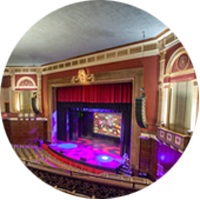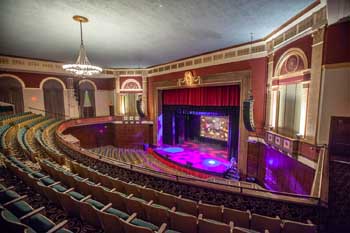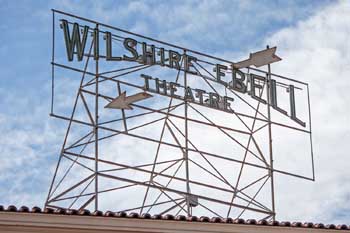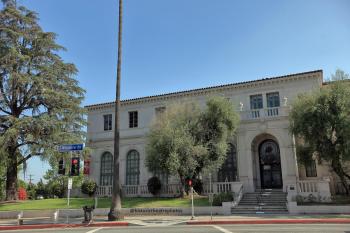

<< Go Back up to Region ‘Los Angeles: Greater Metropolitan Area’
| Follow Mike Hume’s Historic Theatre Photography: |  |
 |

Architects: Hunt and Burns
First Opened: 29th December 1927 (97 years ago)
Former Names: Windsor Square Theatre
Website: ebellofla.org/theatre 
Telephone: (323) 939-1128 
Address: 4401 West 8th St, Los Angeles, CA 90005 
The Wilshire Ebell Theatre is part of a larger complex, completed in 1927, as the clubhouse for The Ebell of Los Angeles  , a prominent Los Angeles women’s club formed in 1894. The theatre is relatively intimate in size, seating just under 1,300, and is well known for its excellent acoustics. It has hosted musical performances and lectures by top artists and world leaders.
, a prominent Los Angeles women’s club formed in 1894. The theatre is relatively intimate in size, seating just under 1,300, and is well known for its excellent acoustics. It has hosted musical performances and lectures by top artists and world leaders.

 Detailed Information
Detailed Information
The etymology of the theatre’s name reflects that of the club, based on the principles and teachings of Adrian Ebell and founded in his name.
Ebell was a pioneer in women’s education and the organization of societies for women in the 1890s. At its forming, the Ebell of Los Angeles’ purpose was stated as being “to interest women in the study of all branches of literature, art and science and the advancement of women in every branch of culture”.
The first formal evening for the clubhouse was held on 22nd October 1927, the occasion being an International Ball. The theatre, originally called the Windsor Square Theatre, first opened to the public on 29th December 1927 with the world premiere of Sigmund Romberg’s new musical The Desert Song. The theatre’s name changed to the Wilshire Ebell Theatre in mid-1930.
The 1927 clubhouse complex, including the theatre, was designed in an Italian style by Sumner P. Hunt of architectural firm Hunt & Burns.

The Wilshire Ebell has played host to many notable performances during its 95 year tenure. Judy Garland, known at the time as Baby Frances Gumm, first auditioned for MGM on the Wilshire Ebell’s stage in the 1930s. Amelia Earhart made her last appearance and public speech on the theatre’s stage before departing on her ill-fated 1937 round-the-world flight.
Igor Stravinsky conducted the premiere of Danses Concertantes at the theatre in 1942, his first major work composed entirely in the United States. Jazz great Dave Brubeck, “one of jazz’s first pop stars” according to the Los Angeles Times, performed at the Wilshire Ebell two years after forming the legendary Dave Brubeck Quartet and one year before appearing on the cover of Time magazine. The album “Dave Brubeck Quartet at the Wilshire Ebell” lives on as a jazz classic.
A major renovation of the theatre took place in 1989 which saw the stage refitted, the auditorium seating and carpets replaced, and new lighting/sounds systems installed.

The American Foundation for Equal Rights held their US West Coast premiere reading of the play “8” at the theatre in 2012. Starring George Clooney, Brad Pitt, Martin Sheen, Jamie Lee Curtis, Matt Bomer, Kevin Bacon, Christine Lahti, John C. Reilly, and directed by Rob Reiner, the star-studded performance benefited the court fight that ultimately led to a historic victory in the Supreme Court of the United States in favor of marriage equality.
The theatre houses a 3-manual, 13-rank Barton pipe organ, dedicated on 24th November 1984  , which is owned and maintained by the Los Angeles Theatre Organ Society
, which is owned and maintained by the Los Angeles Theatre Organ Society  . The organ, originally 10 ranks, was first installed in the National Theatre in Milwaukee, Wisconsin in 1927.
. The organ, originally 10 ranks, was first installed in the National Theatre in Milwaukee, Wisconsin in 1927.
The theatre and particularly the clubhouse complex is a very popular movie and TV filming location. The general location’s headline features include: Columbo, 24, Mad Men, Feud: Bette and Joan, Ghost, Death Becomes Her, Forrest Gump, Air Force One, Catch Me If You Can, Wedding Crashers, and Oscar-winning The Artist. Specific titles filmed at the theatre are listed below.
 Movie, TV & Music Video Appearances
Movie, TV & Music Video Appearances . Features as music hall interiors.
. Features as music hall interiors. . Interior of the Douglas Fairbanks Theatre, where Meryl Streep’s character Madeline Ashton is starring in the musical “Songbird!”.
. Interior of the Douglas Fairbanks Theatre, where Meryl Streep’s character Madeline Ashton is starring in the musical “Songbird!”.

 . The theatre features as the Brooklyn Paramount in New York.
. The theatre features as the Brooklyn Paramount in New York.
 . Featuring as the Apollo Theater.
. Featuring as the Apollo Theater.
 . Acapella concert scene.
. Acapella concert scene.
 . Episode: Pretty Angels All in a Row (1977).
. Episode: Pretty Angels All in a Row (1977). . Episode: Ballerina (1979).
. Episode: Ballerina (1979). . Episode: Mother of Sorrow (1970): closing.
. Episode: Mother of Sorrow (1970): closing. . Episode: Dangerous Memories (1976): Bank robbers hold hostages in the theatre.
. Episode: Dangerous Memories (1976): Bank robbers hold hostages in the theatre. . Episode: Tower of Terror (1997): the theatre features as the Tip-Top Club.
. Episode: Tower of Terror (1997): the theatre features as the Tip-Top Club. How do I visit the Wilshire Ebell Theatre?
How do I visit the Wilshire Ebell Theatre?As of late-2017 the Wilshire Ebell Theare does not offer tours however it hosts many events which are listed on the theatre’s calendar of events  .
.
 Further Reading
Further Reading contains a good amount of information on the theatre and its wider context as part of The Ebell of Los Angeles’ clubhouse.
contains a good amount of information on the theatre and its wider context as part of The Ebell of Los Angeles’ clubhouse. provides a calendar of events, online booking links to a potted history of the theatre.
provides a calendar of events, online booking links to a potted history of the theatre. has detailed information of the theatre’s organ which they own and maintain.
has detailed information of the theatre’s organ which they own and maintain. Technical Information
Technical Information Photos of the Wilshire Ebell Theatre
Photos of the Wilshire Ebell TheatrePhotographs copyright © 2002-2025 Mike Hume / Historic Theatre Photos unless otherwise noted.
Text copyright © 2017-2025 Mike Hume / Historic Theatre Photos.
For photograph licensing and/or re-use contact us here  . See our Sharing Guidelines here
. See our Sharing Guidelines here  .
.
| Follow Mike Hume’s Historic Theatre Photography: |  |
 |